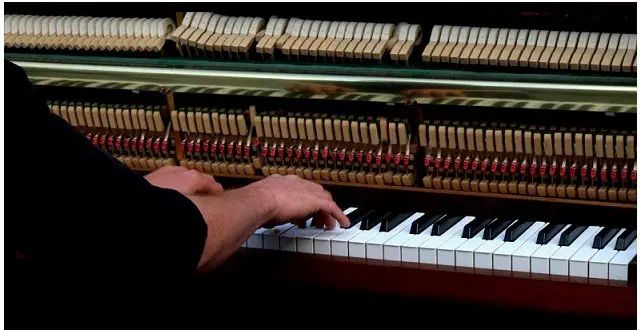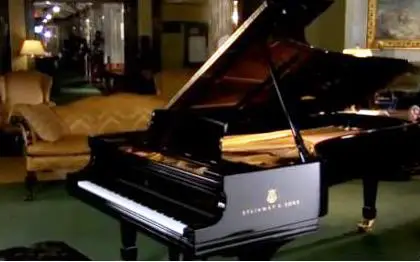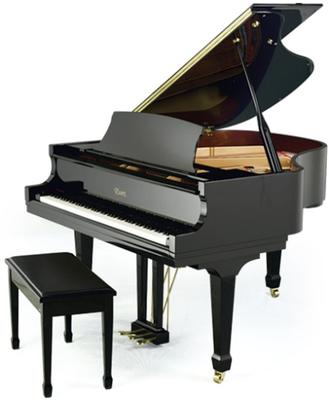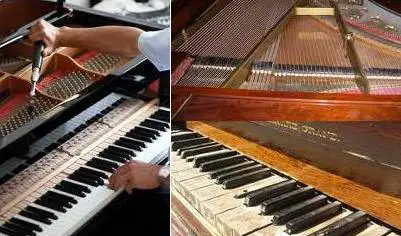
Acoustic Pianos are keyboard instruments with 88 black and white keys; sound on an acoustic is generated by an acoustic mechanism (no sound samples are used).
Introduction
Though digital pianos are more popular nowadays, the acoustic ones still find a place in many homes & schools, especially among those who are big aficionados of arts and music.
Despite the proliferation of digital instruments, piano connoisseurs insist that nothing (referring to digital pianos) can compare to the sound and feel of a real acoustic one, and to some extent, they may be right.

Over the years, with the advancement in technology, the difference between an acoustic and digital instrument (in terms of the sound produced) is diminishing. Digital pianos do have their advantages, but those advantages are more to do with the practicality of the instrument.
While acoustic pianos look and sound awesome, they require expensive maintenance costs; you will need to get your piano tuned regularly… at least every six months.
Acoustic pianos, such as grand pianos, also require more space.
What is an Acoustic Piano?
Acoustic Pianos are keyboard instruments with the keys resembling the keys of an 88-key keyboard.
The word piano is derived from the word pianoforte, which simply means “soft and loud”. Basically it refers to the pianos ability to produce sound at different dynamic levels.
When you press the piano keys, padded hammers strike metal strings, which vibrate along a soundboard, creating the classic acoustic piano sound.
The following applies to all acoustic pianos (irrespective of the piano type):
- Bass notes usually have two strings per note; tenor and treble notes will have three strings per key.
- All base tunings are centered at 440Hz as A.
Here’s more on how pianos work.
Types Of Acoustic Pianos
Acoustic Pianos come in two types – Grand Pianos and Upright Pianos.
All the Upright Pianos are of the same size but a Grand Piano can come in varying sizes (width) depending on whether you want a Grand or a Baby Grand piano.
Grand pianos
These are wider in size because the strings (which produces the sounds) are parallel to the ground and they move away from the keyboard. This makes the Grand Piano, a larger instrument.
A concert Grand will be around 3 meters in width (away from the keyboard).
Since the strings are parallel to the ground, the sound produced travel upwards and spreads throughout the room creating a better sound.

Ideally, a Grand Piano will need a room with higher ceilings for better resonance. That’s the reason you will find most Grand Pianos kept in halls and bigger rooms.
Most manufacturers even make smaller Grand pianos, normally referred to as the “baby grand” pianos. These pianos are around 1.5 meters wide and are used for domestic purposes.
Here are some important features of a grand piano:
- As opposed to an upright, the frame and strings are horizontal, with the strings extending away from the keyboard. The action lies beneath the strings, and uses gravity to return to a state of rest.
- Typical sizes include the concert grand (2.2 to 3 metres long, about 7–10 feet), the parlor grand or boudoir grand (1.7 to 2.2 metres long, about 6–7 feet) and the smaller baby grand (around 1.5 metres (5 feet).
- You have options of both Acoustic as well as Digital
Piano lovers who just do not want to settle for anything less, can consider Baby Grand Pianos.
See Also
Major Piano Brands/Manufacturers of acoustic pianos
Upright pianos
In this type of piano (acoustic type) the strings are laid vertically (parallel to the walls), which means the sound waves would travel horizontally to the floor. Most of the other parts inside the piano are also arranged vertically.
These are much less wider compared to Grand Pianos as the strings are placed vertically.
These are designed to save on space and are comparatively easier to move around.
The smallest upright piano is about 0.85m in height, and includes spinet upright pianos, while the largest is about 1.5m tall.
As a rule, the longer the strings, the better and richer is the tonal quality. That is the reason why the more taller pianos cost more than the shorter ones.
The width of an upright piano does not vary a lot, and is about 1.5m, considering that it will have the same 88 standard sized keys. Although some make do have lesser number of keys, such as 85, or in some cases even 72/73 keys.
You need to make sure that you do not keep your upright piano very close to the wall. This will ensure that the sound resonates properly giving a better sound.

Piano lovers, not inclined towards digital pianos, and for whom, cost and space are important considerations, can consider going in for upright pianos. You can read more on types of pianos here…
The primary reasons why musicians choose an acoustic piano over digital piano.
- The Sound it produces
- The Feel on the keys
Both are difficult to reproduce on a digital piano unless you go in for the more expensive ones.
And why choose an upright acoustic piano over an acoustic grand piano?
This is more of an adjustment, since the later needs more space and costs more.

Types of Upright Pianos
Upright pianos are much less wider compared to grand pianos because the stings are placed vertically i.e. parallel to the walls.
These are designed to save on floor space!
Since the strings are vertical in upright pianos, the piano action is modified compared to a grand piano where the action uses gravity to put the action parts back to their resting position.
In upright acoustic pianos, however, springs are used to return the action parts to their resting position.
Upright pianos are generally categorized into the following four types!
- The Spinet
Height – 36 to 40 inches
Width – around 58 inchesThe spinet is the smallest of all the upright pianos and suits players with limited space.
The limitation of this type of piano is that it has less power and accuracy because of its relatively small size and construction.
- The Console
Height – 40 to 44 inches
Width – around 58 inchesConsoles come in a variety of styles and finishes to match your home.
Slightly larger than the spinet, they are made with a direct action which produces more enhanced tones.
- The Studio
Height – 44 to 47 inches
Width – around 58 inchesThe studio has very good tone quality because it has a larger soundboard and longer strings compared to the spinet and the console.
You will find this type of piano mostly in music studios and music schools.
- The Upright
Height – 47 to 60 inches
Width – around 58 inchesAlso known as the Full-size or the Professional Uprights, these are the tallest of all the vertical pianos, and also among the oldest pianos in existence.
If maintained and taken care-of properly, the uprights maintain their rich tone over many years.
Antique Uprights
If you have been playing the piano for some time now, you would know that the earlier pianos looked more elegant, grand, and were available in beautiful designs.Recent pianos are more practical, compact and simply designed, with the focus being on portability and delivering more features at competitive prices.
However, few decades back, the scenario was different. The antique upright pianos were popular and it was a lucrative business in most counties, especially in the 19th and 20th century.
Considering that pianos were used by the rich and famous, and there were fewer sources of entertainment during that era, no wonder there was good demand for quality pianos.
Popular Ones
The early Victorian upright costs anywhere from around 10000 dollars to about and fifteen thousand dollars, with some of the popular brands being Weber, Wing & Son, Behr brothers and Smith Barnes, Chickering, Steinway & Sons.
The grand pianos were obviously more expensive, with the Victorian baby grand costing anything from around $15000 to $75,000.
Here are some of the more popular versions, which differed a bit in construction:
- Mirror pianos (manufactured during the Second World War)
- Player Reed pianos (Produced in the 1870s and 80s)
- Victorian square pianos
- Victorian parlor pianos
Buying a New / Used One
Buying an acoustic piano requires more research; there’s lot of information on digital pianos, but not really on the acoustic ones.
You should start online and read about the various types, popular brands, their prices and where to purchase them.
When it comes to buying a used acoustic one, it’s always best to check the year of manufacture and also note down the serial number, so that you can better assess its real worth.
Ask your music friends and teachers for more information, and if possible seek expert advice regarding the same.
You could consider buying a used one, but only after you consult a piano professional who can appraise pianos. Appraisals cost money and can be expensive, depending on what sort of piano is being appraised, and so it is better to shop for the best value for money.
Also, it’s important to remember that refurbishment of antique pianos does not diminish the value of the piano. In fact, in some cases, it can even increase the value of your piano if proper repair work is carried out.
The Digital Version
Take a look around, and you’ll find that a digital piano is what most beginners and students begin on. Its practical in most homes where space is a constraint, no wonder that these are extremely popular in developing countries and most cities.
At the most basic level, you get uprights that come with detachable stands, so when you buy, you need to assemble the parts once it’s delivered to your place.
Checkout the popular digital pianos here…
Current Scenario
There is no doubt that the world is moving to digital, and there are plenty of options available at the lower price range. However, companies are also trying to make high-end digital pianos as there’s good demand for those as well, as users want to integrate their musical instrument with other electronic equipment/gadgets.
Even in the acoustic piano space, more and more budget pianos are getting manufactured in countries such as Brazil, Korea, and Brazil, and several upright pianos exported from these regions. If you’re a serious musician, you may still find an antique/acoustic upright piano of value, which can be quite refreshing & inspirational, compared to most modern digital pianos.
How much does an Acoustic piano Cost – Student Looking for upright piano prices
Question:
I want to buy an upright acoustic piano and am looking for options for around $2000. Ideally $1500 would be best but I know the acoustic pianos tend to be more expensive than the digital ones. My friends suggested that i start on a beginner digital piano but then i have heard them and the cheaper ones dont sound good at all. Dont find it inspiring at all. Am looking for upright piano prices for some good entry level acoustic upright pianos. – Claire

Answers:
Checkout the Yamaha ARIUS YDP series or the Casio Celviano (bit cheaper). Both should serve your purpose and also save time/money in maintenance costs.
Acoustic piano – RJ
Good Acoustic pianos can be expensive but if you are really serious about learning piano, and if you’re want something that is really elegant and complements/enhances the decor of your house, by all means go for it. However, it doesn’t mean all digital pianos are cheap. The cheapest ones may not be of the desired looks (though they do serve a purpose) but the more expensive ones not only sound good they look also good. The good ones can cost anywhere from a couple of thousand grands to about five thousand dollars. Not cheap…isn’t it. But they are good. You can check out the various options here. – Peter
KeytarHQ editorial team includes musicians who write and review products for pianists, keyboardists, guitarists & other musicians. KeytarHQ is the best online resource for information on keyboards, pianos, synths, keytars, guitars and music gear for musicians of all abilities, ages and interests.



Leave a Reply